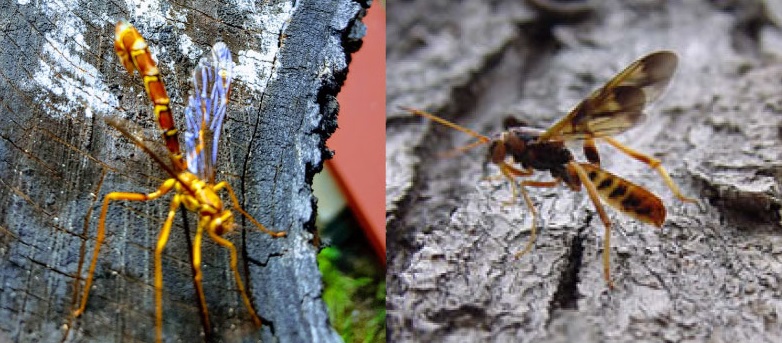SCORES & OUTDOORS: An ugly, scary looking wasp that isn’t so scary, after all
 by Roland D. Hallee
by Roland D. Hallee
A little while ago, the pastor at my church sent a photo to me of a bug he spotted at his camp. It was a scary looking bug that neither of us had ever seen before. It was yellow in color, had long legs and a long protruding appenditure that resembled a stinger.
So, it was time to call on my friends at the Maine Forest Service for some input. Here is what we found.
The bug is called the Giant Ichneumon Wasp, Megarhyssa macrurus.
There are several different species of Ichneumon Wasps, each with its own color variations. Some are black and yellow, others reddish and striped. All have the Ichneumon Wasps body shape: a thin waist and an abdomen longer than the rest of the body.
Females have a long, needle-like ovipositor which is often mistaken as a stinger. The sturdy ovipositor acts like a syringe, injecting eggs deep into wood (live trees or logs) where the larvae will feed on any other insect larvae already deposited there. It is not uncommon to see females poking around wood in an attempt to find a good place to deposit her eggs. Males do not have the ovipositor so their abdomen are shorter. Both genders are still wasps, however. Despite their large size and being “wasps” these are harmless to humans and unable to sting.
Giant Ichneumon Wasps tend to live in wooded areas and throughout all of North America, though they do stay away from arid and hot desert regions and scarcely treed central plains.
Ichneumon Wasp adults do not eat at all. Larvae are parasites of Pigeon Horntail larvae, another type of wasp that deposits eggs in wood. The Ichneumon wasp larvae will hatch and feed on the Horntail Wasp larvae.
When an insect develops on a single host, and kills the host in the process, it is called a parasitoid. Parasites, on the other hand, tend to nibble on their hosts without killing them. And predators kill more than one of their prey items.
The giant ichneumon wasp is a parasitoid, notable for its extremely long ovipositor which it uses to deposit an egg into a tunnel in dead wood bored by its host, the larva of a similarly large species of horntail. Another of its common names is stump stabber, referring to its behavior.
When a parasitoid kills its host, it can indeed be a gruesome sight. Typically, an adult female parasitoid lays an egg on the surface of, or into the body of, a living larva of another insect. When the egg hatches, the parasitoid proceeds to consume the host, piece by piece. Like a cat with a mouse, it keeps its victim alive as long as possible. Dead larvae rot quickly, and this makes the meal less attractive. First the parasitoid eats the fat bodies of the larva, then the digestive organs, keeping the heart and central nervous system intact for as long as possible. Finally, they are eaten as well and the long-suffering victim dies, leaving an empty caterpillar shell.
The slow death inflicted by parasitoids that attack other insects tested the concept of a benevolent God for 19th century theologians who discussed this practice at length. Even Darwin had trouble with the largest parasitoid family as he wrote to Asa Gray in 1860: “I cannot persuade myself that a beneficent and omnipotent God would have designedly created the Ichneumonidae with the express intention of their feeding within the living bodies of caterpillars….”
The female giant ichneumon wasp is a striking animal, two inches long, boldly patterned in brown, orange and yellow. Her two- to -four-inch long ovipositor with its two protective filaments looks like three long tails. Some parasitoids can choose to lay their eggs on a variety of host species, but giant ichneumon wasps need to find a larva of a pigeon horntail. Nothing else will do.
The ovipositor looks like a single filament, but it comprises three filaments, the middle one of which is the actual ovipositor, which is capable of drilling into wood. This central filament also appears to be a single filament, but is made of two parts, with a cutting edge at the tip. The two parts interlock and slide against each other.
Although very thin, the ovipositor is a tube and the egg being laid moves down a tiny channel in its center. The outer two filaments are sheaths which protect the ovipositor; they are out to the sides during egg-laying
The presence of giant ichneumons on a tree is not a good sign because they are an indication that horntail wasp are attacking the tree. Horntail wasps attack trees that are already under stress. Often by the time the wood-boring insects have started attacking the tree it is in irreversible decline.
Fortunately, for my pastor, the giant ichneumon wasp he saw was on a dead stump of a tree, and not on a healthy one.
Roland’s trivia question of the week:
For how many teams did NFL quarterback Joe Montana play?
Responsible journalism is hard work!
It is also expensive!
If you enjoy reading The Town Line and the good news we bring you each week, would you consider a donation to help us continue the work we’re doing?
The Town Line is a 501(c)(3) nonprofit private foundation, and all donations are tax deductible under the Internal Revenue Service code.
To help, please visit our online donation page or mail a check payable to The Town Line, PO Box 89, South China, ME 04358. Your contribution is appreciated!



How long do they live?
Well they kill the tree?
Where they come inside the house?
We have a problem for me six on one tree branch alone.